You can still reinstall Windows 10 on a computer even if you don’t have a CD or USB drive. MiniTool introduces 3 ways to easily reinstall Windows 10 without CD or USB. Now follow the step-by-step guide to reset the PC, perform an in-place upgrade, or clean install the system.
You may encounter such a case:
You have a Windows 10 tablet or laptop and plan to reinstall the system. However, the only USB port is broken, or you don’t have a USB drive.
Is it possible to reinstall Windows 10 without CD or USB?
Of course, you can do that. It sounds like a challenge, but it is simpler than you think.
We will walk you through a comprehensive guide to run this task with ease.
Why Reinstall Windows 10
Reinstalling Windows 10 is often done to solve a variety of errors & issues, remove viruses & malware, and improve the system performance. If you want a clean system, it can be a good idea to reinstall the system.
Fix System Errors and Issues
In Windows 10, you may encounter persistent errors, blue screen issues, and system crashes. These issues cannot be resolved through other methods. Reinstalling is the last troubleshooting tip.
Besides, errors, crashes, and other issues may stem from conflicts between software. Clean installing the OS helps eliminate those conflicts.
Moreover, when handling hardware issues, reinstalling can determine if the problem is software-related.
Improve System Performance
Over time, you may get a cluttered system full of temporary files, residual software, outdated drivers, and more. This can slow down your computer.
Universal methods like clearing junk files may not significantly boost the PC. In this case, consider reinstalling Windows 10 to remove these files, returning the system to a pure state.
Besides, reinstallation can be a good option when the computer is very slow and unresponsive.
Remove Virus and Malware
Your system is infected with viruses and malicious software, but the antivirus software cannot fully remove these threats.
It is necessary to reinstall Windows 10 to effectively delete the viruses and malware. The process erases everything on the disk and installs a fresh copy of the system.
Set up a New Device or Want a Fresh Start
You plan to remove all your old apps, settings, and data for a fresh start. During the installation process, you can configure the system with your preferred settings. Then install the desired apps from scratch.
Besides, it is also a good option when setting up a new device.
What to Do Before Windows 10 Reinstallation
#1. Check the Disk Space
Ensure your disk has sufficient space before reinstalling Windows 10 without a USB drive or CD. This aims to accommodate the new Windows installation. Windows 10 requires 32GB or more for installed apps, updates, temporary files, and more.
#2. Back up Data
Personal files on the hard drive will be deleted when performing the system reinstallation. Be sure to back up essential files beforehand.
Regardless of the method you use to reinstall Windows 10 without CD, ensure data loss prevention through backups.
What to back up? Here is a list of files.
- User data: Backup files in the Documents, Videos, Music, Pictures, Downloads, and Desktop folders.
- Personal data: This involves important personal videos, photos, downloaded files, and more in other drives. Back up them if you plan to remove everything on the hard drive when reinstalling Windows.
- Passwords: To back up your passwords, use a password manager.
- Save games: It is necessary to back up your save files to avoid playing games from scratch.
- Program licenses: Some apps need to be registered, so back up the license keys.
- Browsing data: Bookmarks and saved passwords for websites should be backed up. If you use Google Chrome, turn on the sync feature. After reinstalling Windows 10, log in to the same account, and bookmarks and other data are automatically synced.
Where to store the backup?
- An external hard drive or USB flash drive
- Network-attached storage (NAS)
- Cloud storage like Google Drive, OneDrive, Dropbox, etc.
How to back up crucial pictures, videos, documents, and other files? Here we take an external hard drive as an example.
For this task, MiniTool ShadowMaker is recommended. This backup software works well in Windows 11/10/8/7 and Windows Server 2022/2019/2016. It supports multiple data types, such as file backup, folder backup, disk backup, system backup, and partition backup.
Importantly, automatic backups, incremental backups, and differential backups become easy with this program. Just get it for a trial.
MiniTool ShadowMaker TrialClick to Download100%Clean & Safe
Step 1: Plug your external drive into the computer and run MiniTool ShadowMaker.
Step 2: Navigate to Backup > SOURCE > Folders and Files. Then, choose the files or folders you wish to back up, such as game files, pictures, documents, etc.
Step 3: Hit DESTINATION to pick the external drive to save backups.
Step 4: Start the backup by clicking Back Up Now.
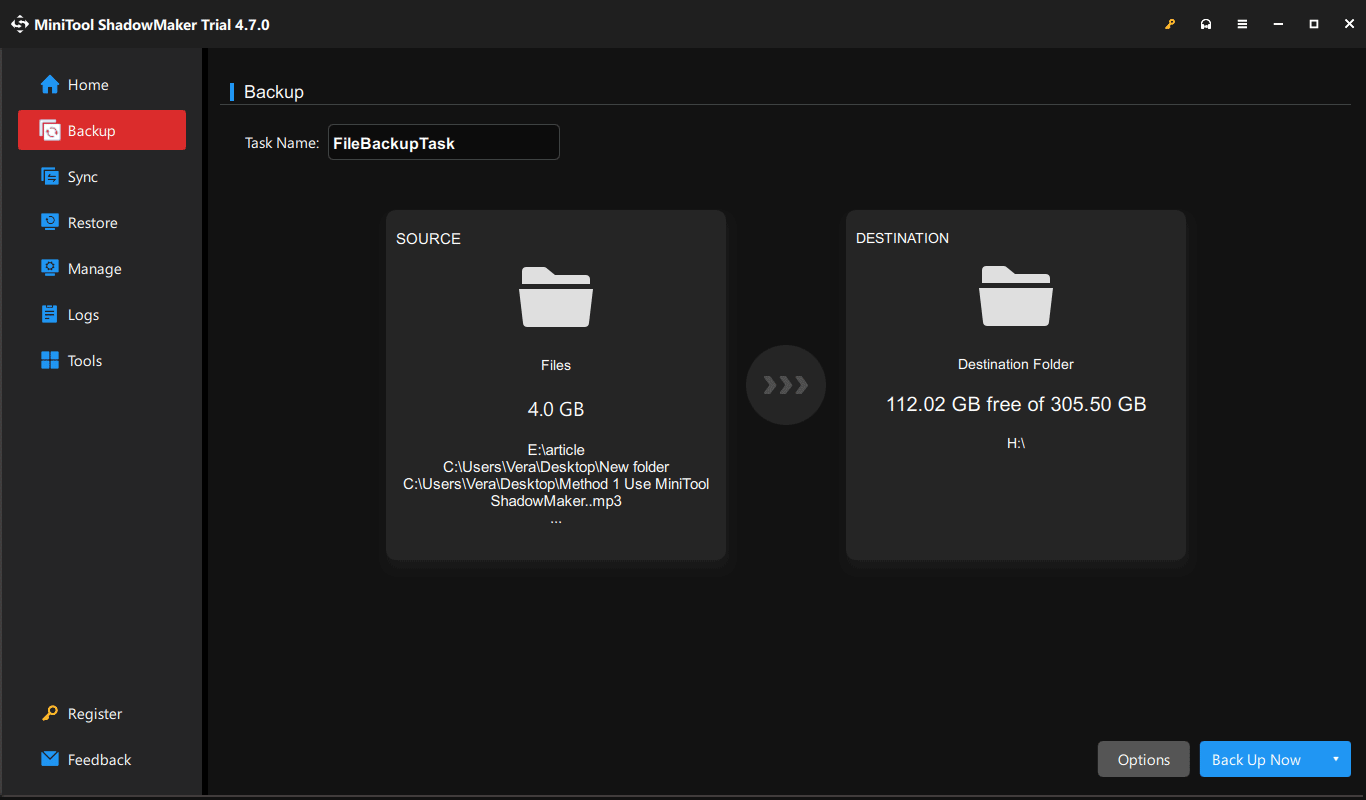
#3. Disconnect Unnecessary Peripherals
Before reinstalling Windows, make sure you unplug any unnecessary external devices. Only keep the mouse and keyboard connected to the PC.
#4. Note Down Windows Product Key
If you don’t link the license key to your device, write down the key. Otherwise, you lose that key to activate the system. You had better link the digital license to your Microsoft account.
#5. Choose a Proper Windows Edition to Install
Note that the Windows edition must match your digital license when reinstalling the system. For instance, if the current edition is Pro, you must reinstall Windows Pro. To check which Windows edition is running, go to Settings > System > About.
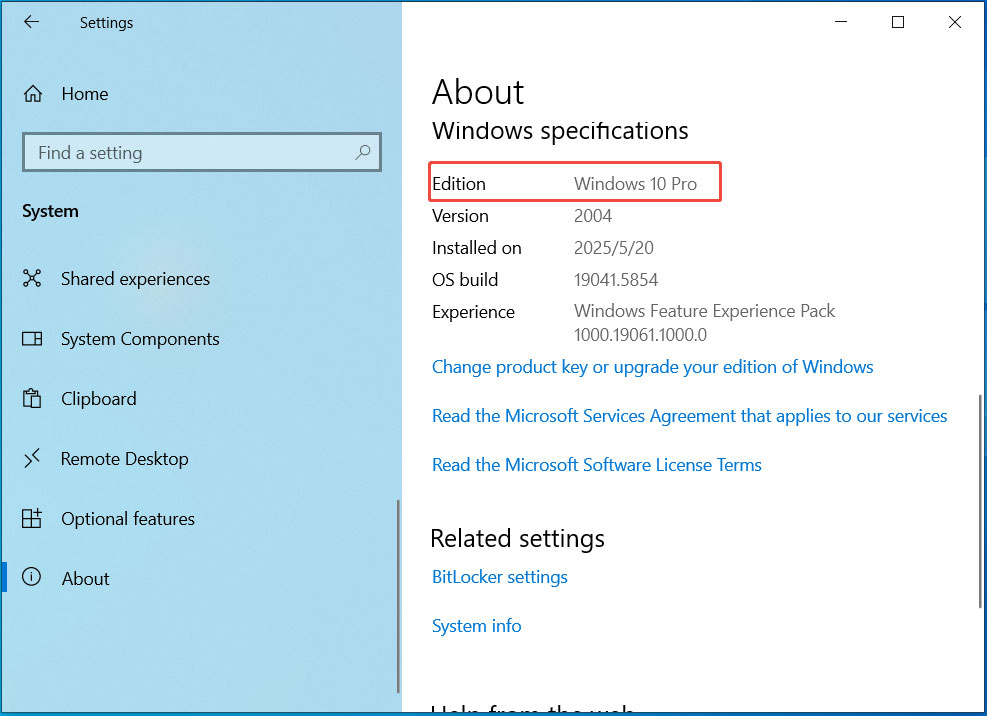
How to Reinstall Windows 10 Without CD or USB
There are 3 main methods to reinstall Windows 10 without a drive. You can reset your PC or download an ISO file and perform an in-place upgrade. Also, you can perform a clean installation via Command Prompt.
Without further ado, let’s get started.
Method 1: Reset This PC (in Normal Boot/WinRE)
Windows 10 comes with a feature called Reset this PC. It allows you to keep personal files while removing apps & settings, or remove everything, and then reinstall Windows. Resetting is a good solution for a PC that isn’t working well. Importantly, this way doesn’t require any key and CD/USB.
So, how to reinstall Windows with no CD in this way?
Case 1: The system can boot properly
Step 1: Hit the Start button and choose Settings.
Step 2: Navigate to Update & security > Recovery.
Step 3: Under Reset this PC, hit the Get started button.
Step 4: Choose an option to continue as per your needs.
- To reinstall Windows 10 without losing data, you should choose Keep my files. But this can remove apps and settings.
- To get a fresh Windows system, hit Remove everything. This deletes all personal files, apps, and settings.
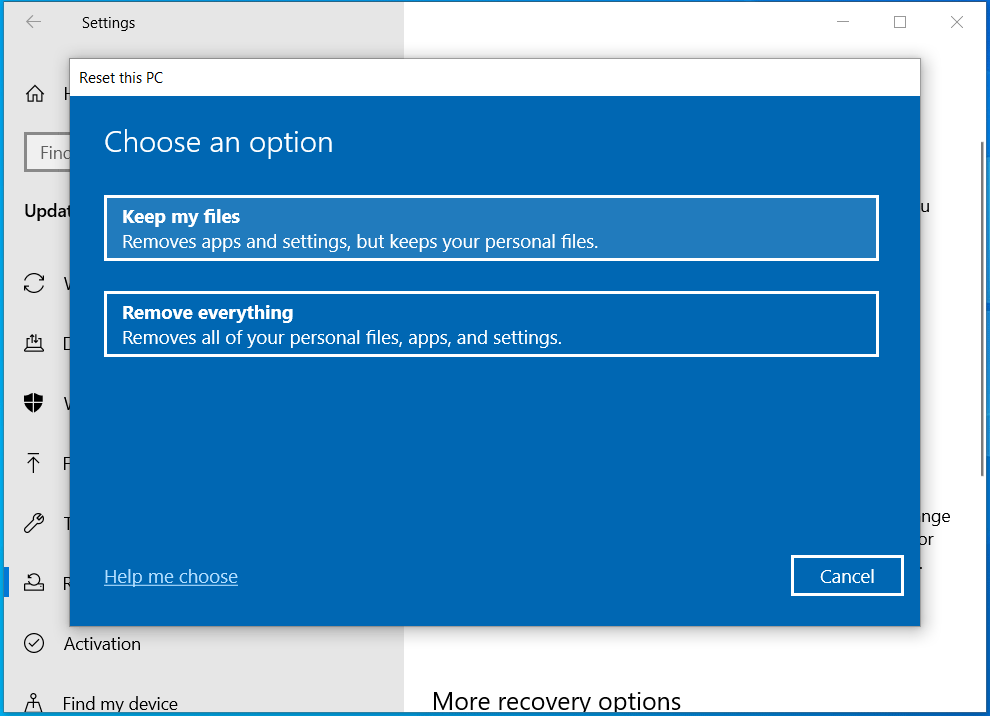
Step 5: Decide how you would like to reinstall Windows: Cloud download or Local reinstall.
- Cloud download: It downloads the necessary Windows files from Microsoft’s servers. Choose it if you wish to obtain the latest updates and fresh system files. Ensure you have a reliable internet connection.
- Local reinstall: It uses existing Windows files to reinstall the PC. Just select this option when the network is unavailable or limited.
Step 6: Confirm the settings, get ready, and then click Reset to begin.
Case 2: The system fails to boot
How to reinstall Windows 10 without CD or USB in this situation?
Piece of cake!
Step 1: Turn on the computer and press Power to interrupt the boot process when seeing the Windows logo. Repeat this process 2 or 3 times.
Step 2: Windows will enter the Automatic Repair interface, and then hit Advanced options.
Step 3: In WinRE, go to Choose an option > Troubleshoot > Reset this PC.
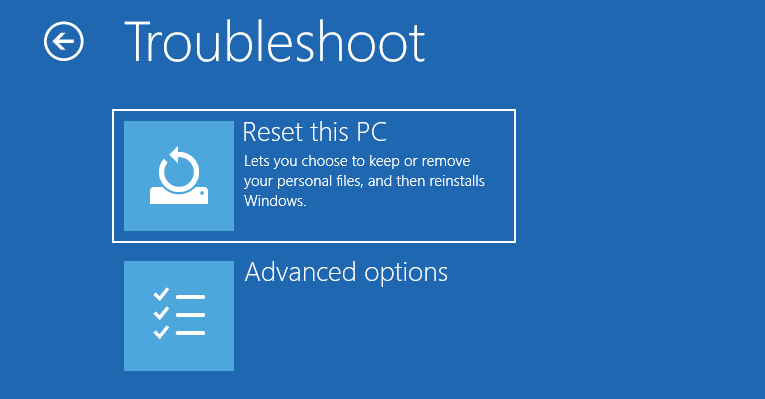
Step 4: Choose Keep my files to reinstall Windows 10 without losing data.
Step 5: Complete the reinstallation by following the prompts.
Method 2: Reinstall Windows 10 Without CD via In-Place Upgrade
An in-place upgrade involves installing a newer version over the existing installation. It allows for the reinstallation without losing data since it preserves files, settings, and installed apps.
Also, you can run an in-place upgrade to resolve some issues caused by failed updates, corrupt system files, and more.
Here is how to reload Windows 10:
Step 1: Download a Windows 10 ISO file first.
1. Download Media Creation Tool from Microsoft.
2. Launch this tool and accept the applicable notices and license terms.
3. Tick Create installation media (USB flash drive, DVD, or ISO file) for another PC.
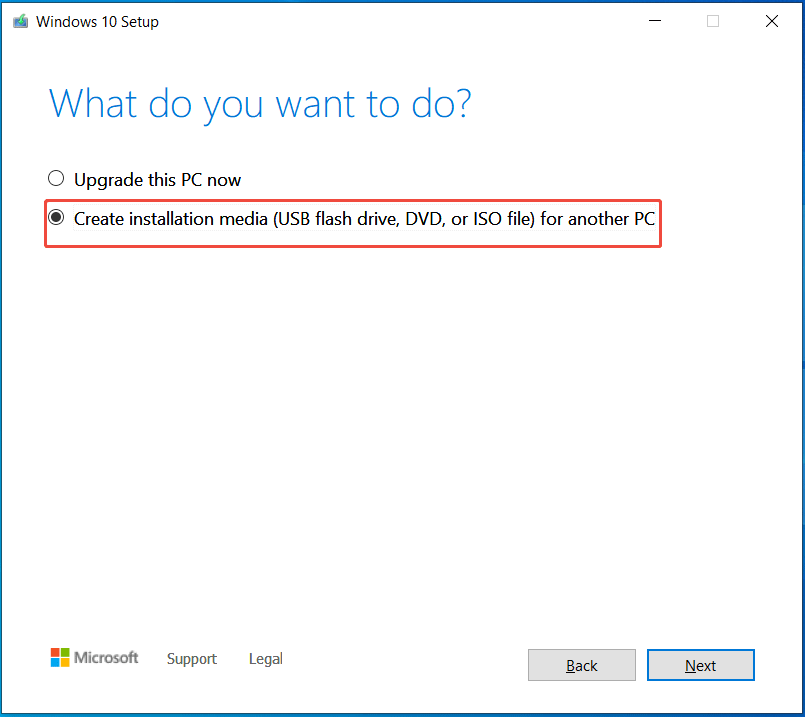
4. Choose a language, architecture, and edition.
5. Check ISO file, select a location to save that ISO file, and then the download process begins.
Step 2: Mount the ISO file to install Windows 10 without a USB drive or CD.
1. Right-click on that ISO image and choose Mount.
2. You get a virtual drive. Open it.
3. Double-click on the setup.exe file to launch the installer.
Step 3: Configure the installation settings
1. Windows Setup will download updates, drivers, and optional features to ensure a smooth installation. To proceed, click Next. We recommend this option.
Or hit Change how Windows Setup downloads updates, tick Not right now, and hit Next.
2. After getting some things ready, accept the license terms to continue.
3. The setup will take some time to get updates.
4. On the Ready to install interface, confirm the settings.
You are allowed to choose another option by clicking Change what to keep.
Here are 3 options:
- Keep personal files and apps: It is selected by default. To reinstall Windows 10 without losing programs and files, use this mode.
- Keep personal files only: To reinstall Windows 10 without losing files, choose this option. Settings and apps will be deleted.
- Nothing: Everything, including files, apps, and settings, will be deleted. This creates a fresh copy of the Windows operating system.
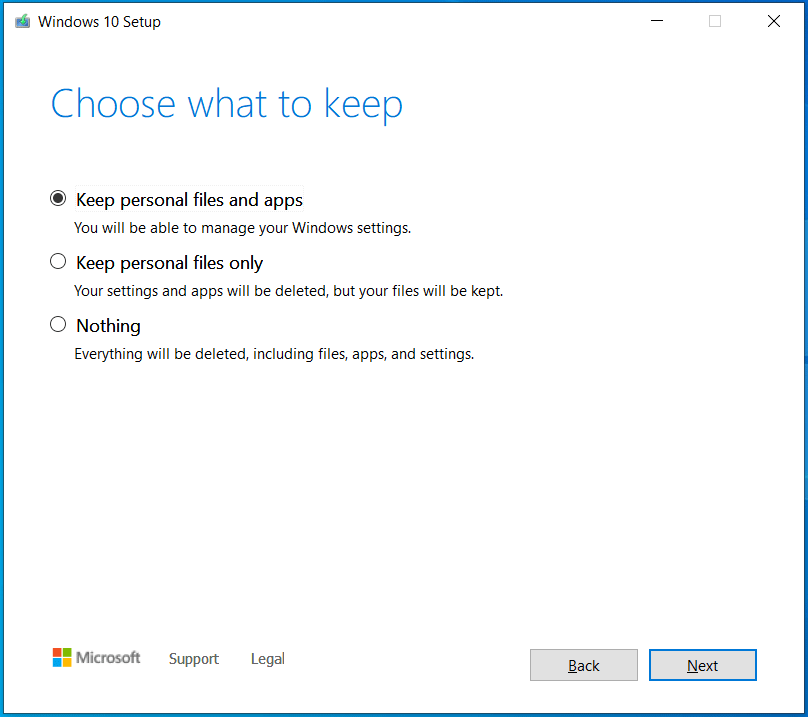
Step 4: Begin the installation.
1. Hit Install to reinstall Windows 10.
2. Once completed, set up the system as per your preferences.
Method 3: Clean Install Windows via Command Prompt
If you don’t have a USB drive or CD, you can still perform a clean installation. Do this via Command Prompt in Windows Recovery Environment (WinRE).
Let’s explore how to reinstall Windows 10 without CD or USB.
#1. Do Preparatory Work
- Download a Windows 10 ISO image using Media Creation Tool and mount it.
- Shrink a partition on the device in Disk Management to allocate 10GB of free space. Then, create a new partition. You can set a label for it, such as win setup to help you identify it.
- Open the new partition, copy & paste all the mounted data to that folder.
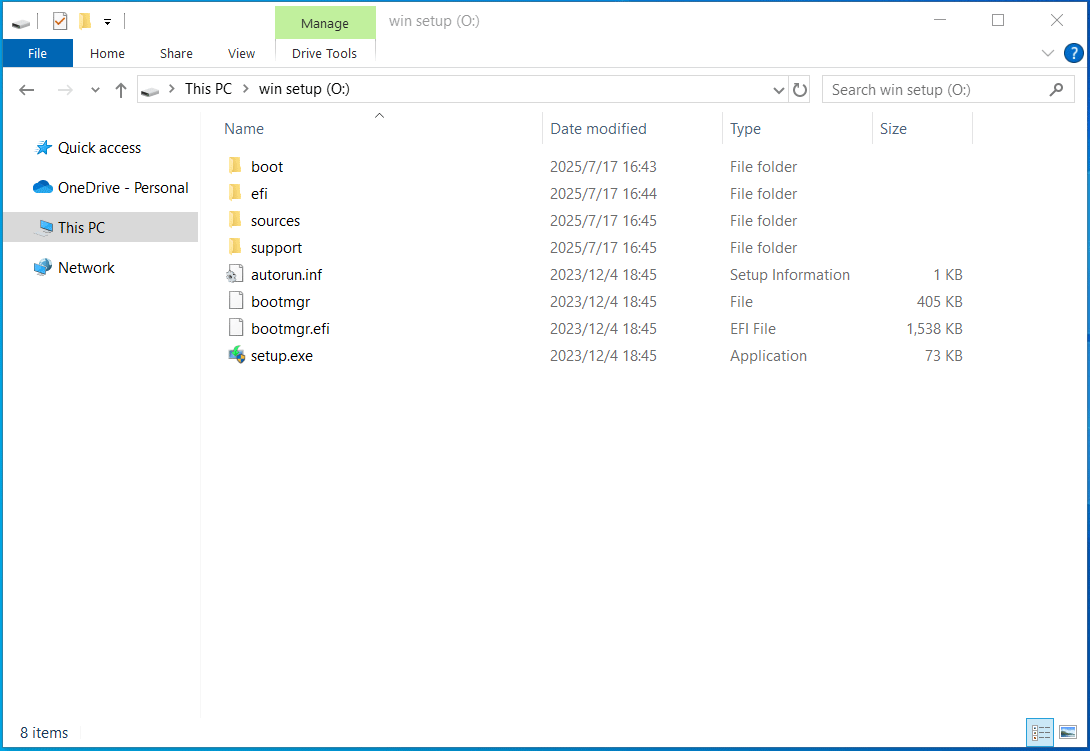
#2. Boot to Command Prompt in WinRE
- To do this task, boot Windows 10 to Windows Recovery Environment by forcing a restart 3 times.
- Go to Troubleshoot > Advanced Options > Command Prompt.
Next, reinstall Windows 10 without CD/USB by choosing a proper option.
#3. Run Windows Setup from the Partition on the Same PC
Step 1: Identify partitions
First, you need to identify the created partition in Command Prompt, as drivers may change in WinRE.
For this, you need to enter these commands and press Enter after each one:
- diskpart
- list volume
- exit
Note down the drive letter of the partition that is labeled with win setup. In my case, it is the drive H.
Step 2: Set up a clean installation
1. Launch Windows Setup using the command: H:\setup.exe.
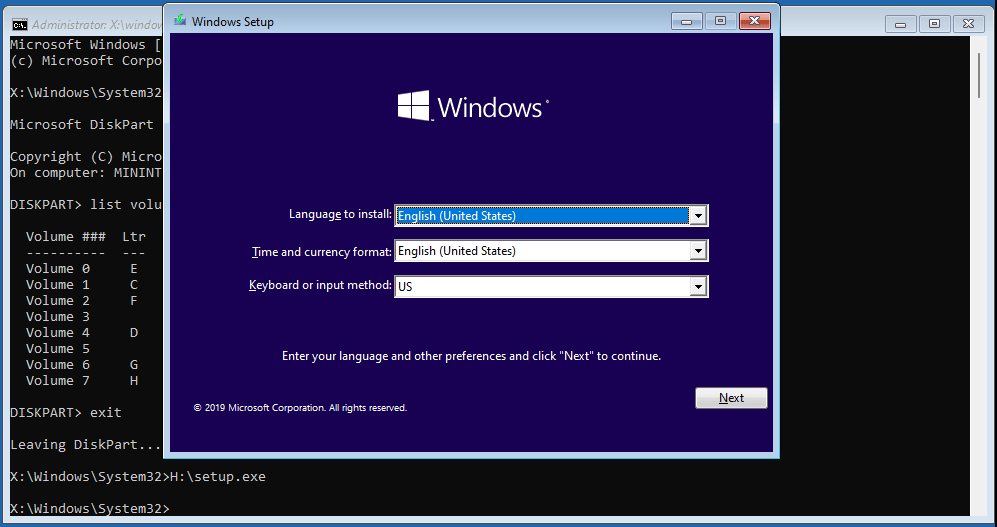
Alternatively, you can use another way to launch Windows Setup in Command Prompt. Type these commands:
- H:
- cd sources
- setup.exe
2. Choose your language and other preferences, then click Next > Install now.
3. Enter your product key. Or hit I don’t have a product key.
4. Accept license terms.
5. Choose a Windows 10 Edition to install.
6. Click Custom: Install Windows only to reinstall the system.
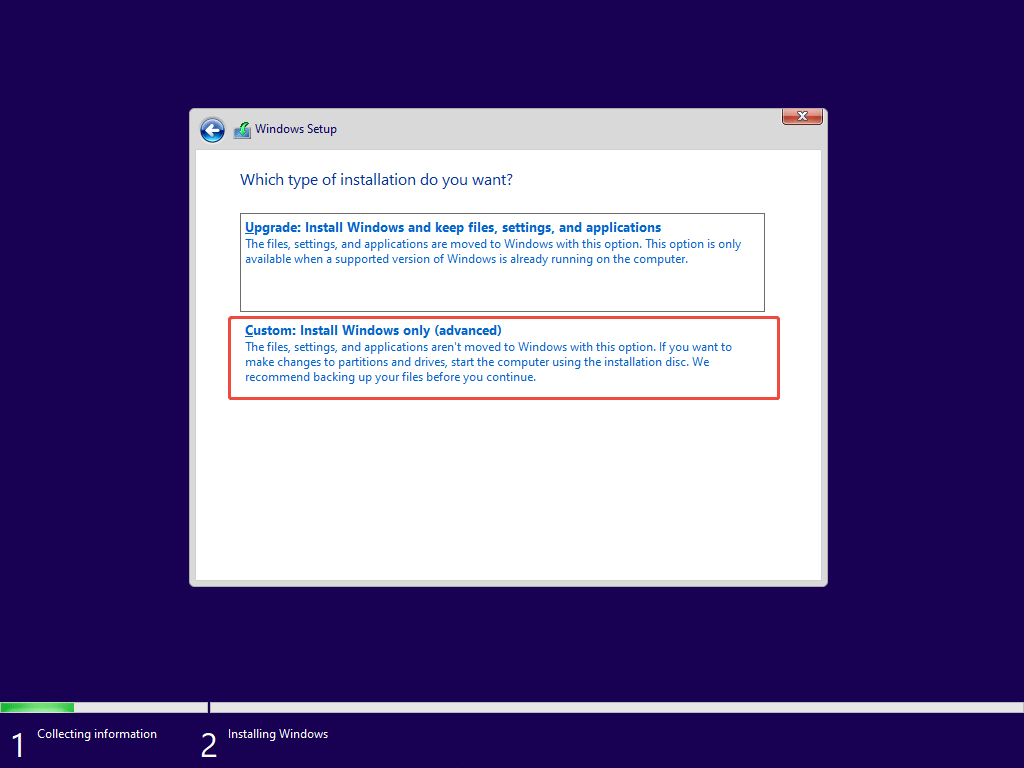
7. Choose each partition except the one labeled as win setup, and click Delete.
8. Select the unallocated space to create a new partition. Then, start installing Windows 10 on that drive.
How to Install Windows 10 from USB
In case you have a USB drive, how can you reinstall Windows 10? You need to create a bootable USB flash drive, boot the machine from that drive, and perform the clean installation.
Step 1: Create a Bootable USB Drive
1. Run Windows 10 Media Creation Tool to download an ISO file.
2. Download Rufus and launch it.
3. Connect a USB drive to your computer.
4. Configure something in Rufus and hit Start to begin burning ISO files to the USB drive.
Alternatively, you can run Media Creation Tool to directly download Windows 10 installation files to a USB drive. In the Choose which media to use interface, tick USB flash drive.
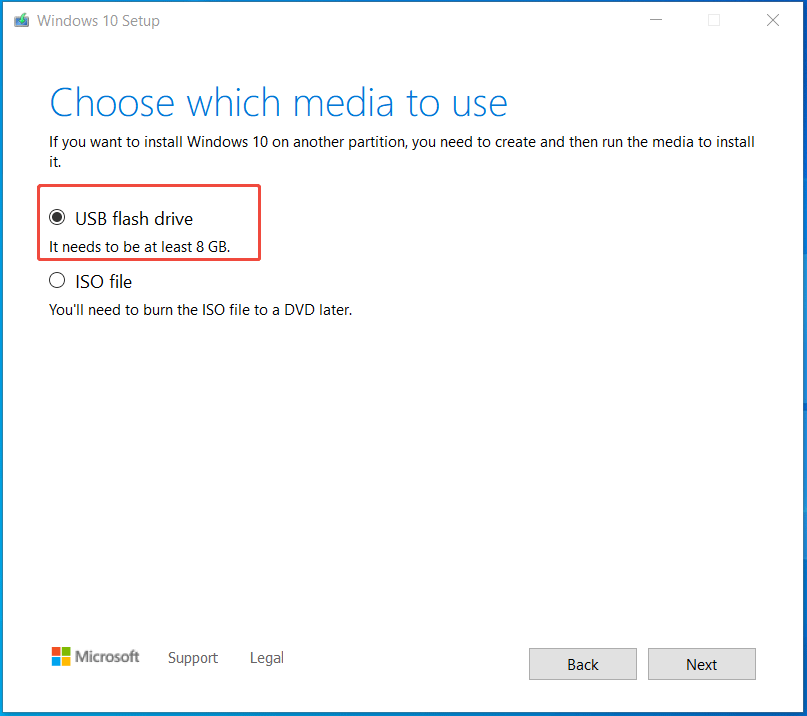
Step 2: Boot Windows from USB
1. Power on the machine and press F2, Del, Esc, or another boot key to access the BIOS menu. The key differs among computer manufacturers.
2. Set the USB drive as the first boot sequence.
3. Start up the system.
Step 3: Install Windows 10 from USB
1. Choose keyboard, language, etc.
2. Click Install now.
3. Follow the on-screen instructions to complete the installation process.
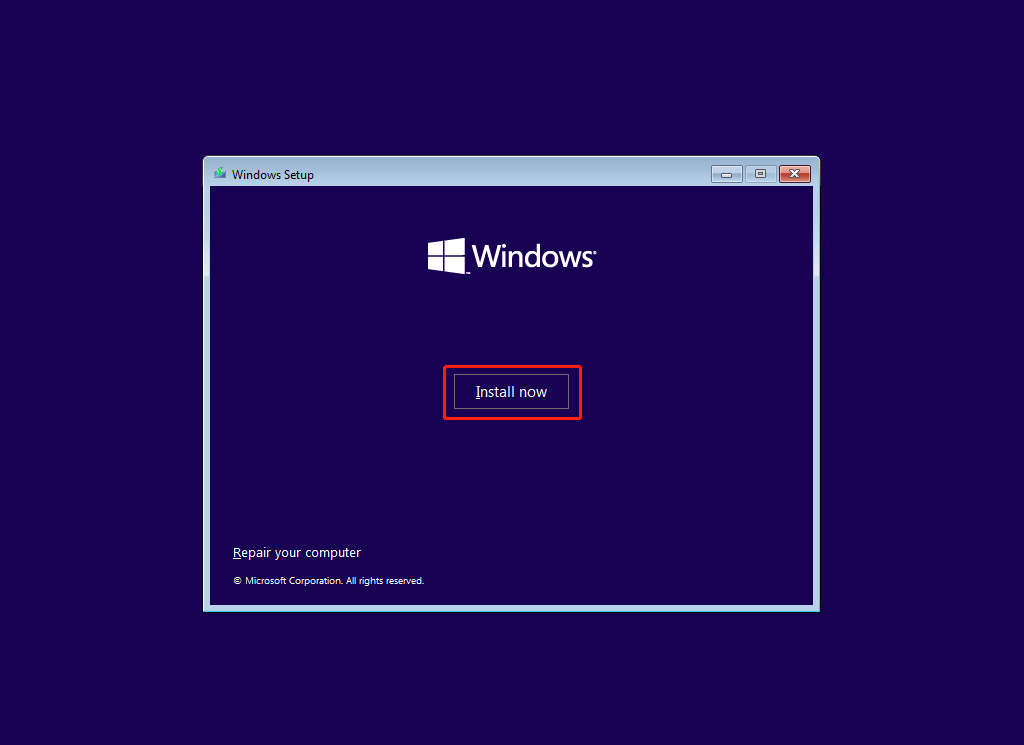
How to Install Windows 10 on a New Hard Drive
Some of you may be interested in Windows installation on a new hard drive.
So, how to reload Windows 10? It is possible to clean install the system from a bootable USB drive. Follow the steps above.
Aside from that, you can use a migration tool to migrate Windows 10 from one drive to your new drive. This avoids reinstalling the system and apps, without data loss. We highly recommend running MiniTool ShadowMaker.
It comes with the Clone Disk feature, allowing for moving Windows to another drive and cloning an HDD to an SSD.
MiniTool ShadowMaker TrialClick to Download100%Clean & Safe
Here is how to install Windows 10 on a new hard drive:
Step 1: Connect the new disk to your computer and launch MiniTool ShadowMaker.
Step 2: Head to the Tools page and hit Clone Disk.
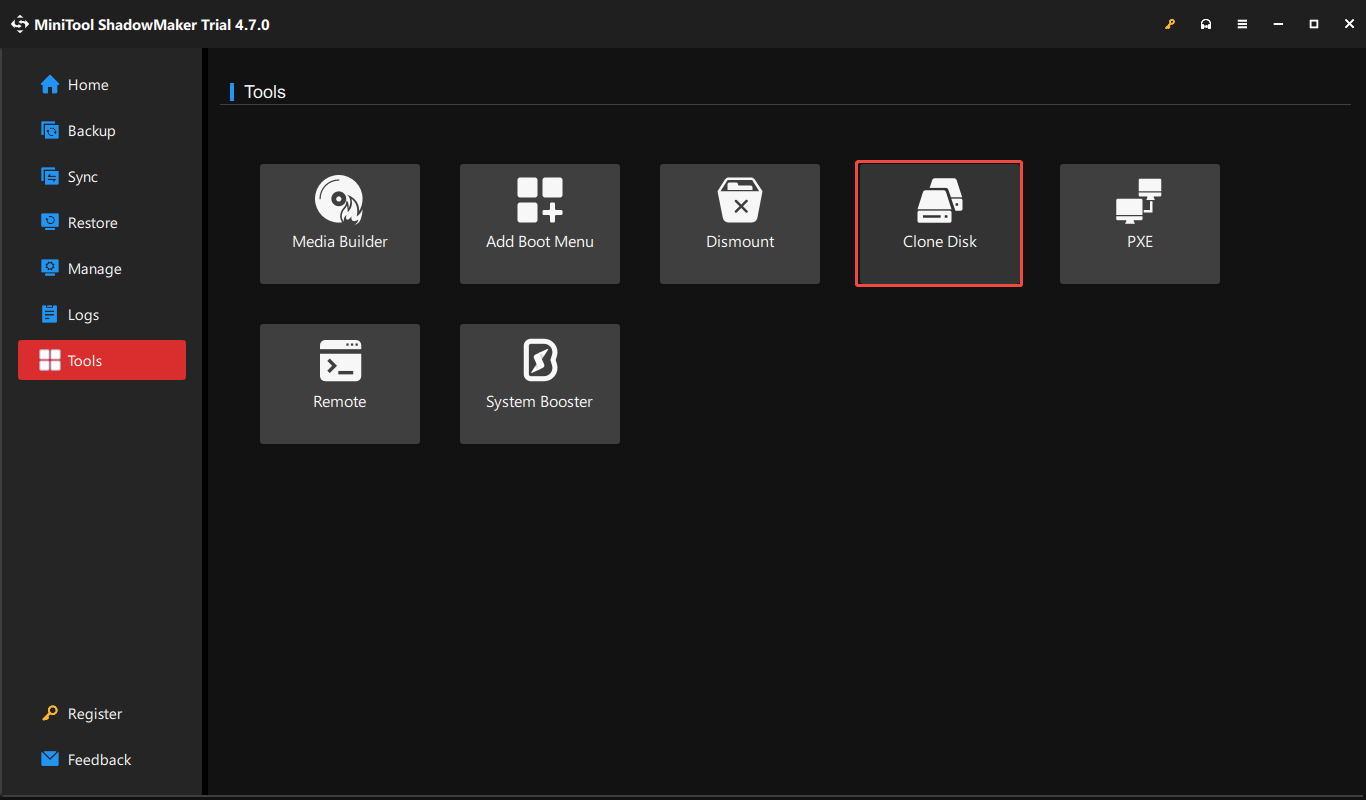
Step 3: Select the disk that holds the Windows 10 system as the source drive. Then, choose the new disk as the target drive.
Step 4: You are required to register the software when dealing with system cloning. Do that and then begin cloning.
What to Do After Reinstalling Windows 10
Whether you reinstall Windows 10 without CD or from USB, there are some tasks to perform after the installation process.
Here is a list.
Suggestion: Back up System
Make sure you create a system image for the computer.
A system image includes all the Windows OS files, settings, programs, and personal files. Once the device goes wrong, it is a good option to restore Windows to a normal state. And you won’t need to spend much time and effort fixing issues, even reinstalling the system.
In terms of system backup, MiniTool ShadowMaker also comes in handy.
To do that:
Step 1: Connect an external hard drive to your PC.
Step 2: Open MiniTool ShadowMaker and head to its Backup page.
Step 3: By default, this free backup software chooses the current system partitions under SOURCE. You only need to go to DESTINATION to choose the connected external drive.
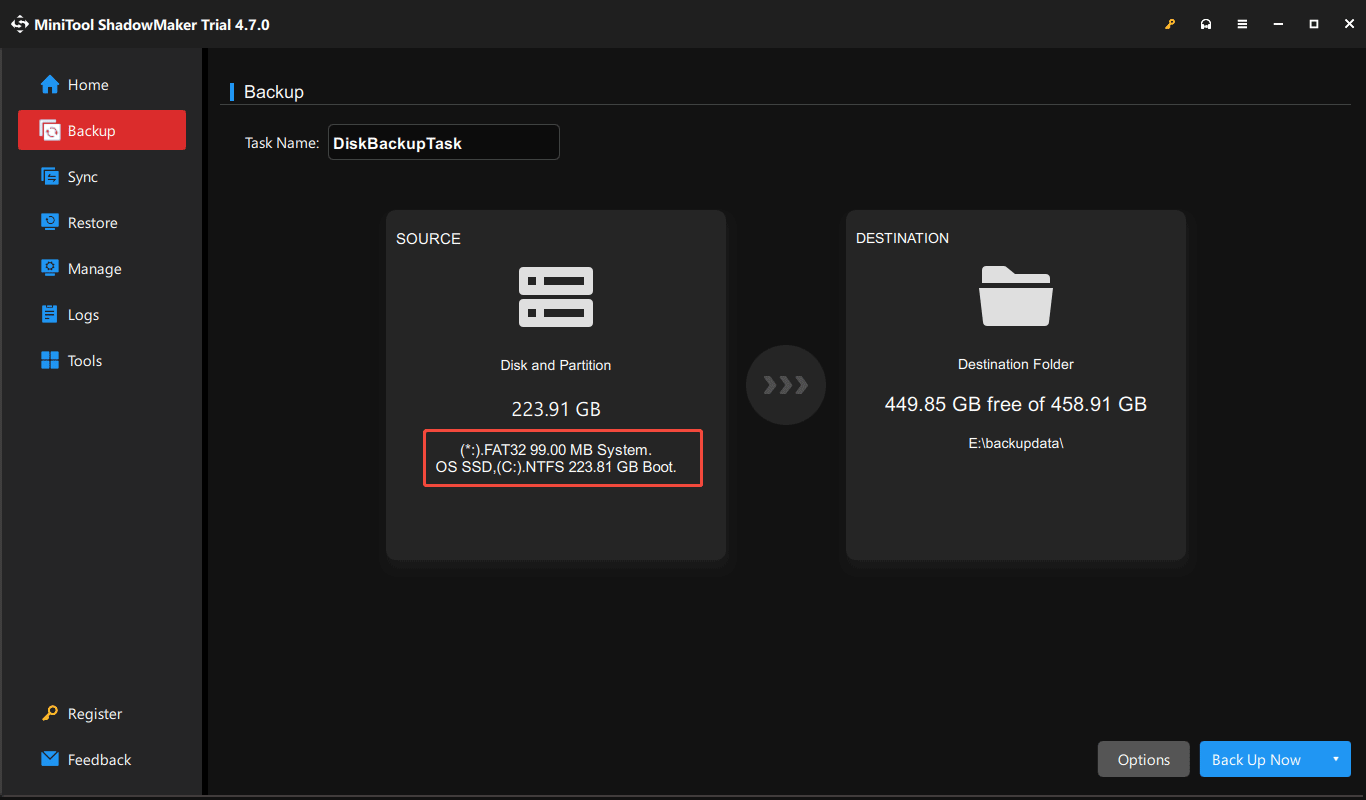
Step 4: Hit Back Up Now to create a system image.
Other Measures to Take
- Update Windows: Go to Settings > Update & Security > Windows Update, check for updates, and install them.
- Update Drivers: Download and install the latest drivers for the graphics card, motherboard, etc., from the manufacturers’ websites.
- Activate Windows: If you don’t activate Windows 10, navigate to Settings > Update & Security > Activation to activate it.
- Install Essential Programs: Download and install the applications you need, such as Chrome, Photoshop, etc.
- Enable Windows Defender: Make sure this antivirus software is enabled.
The End
It is not difficult to reinstall Windows 10 without CD or USB. By following the instructions above, you can easily achieve your aim. Depending on your situation, try to reset your PC, perform an in-place upgrade, or clean install Windows 10 in Command Prompt.
In this post, you have also learned how to install Windows 10 from a USB drive and on a new hard drive, as well as what to do after the installation.
You can always find what you need. Then, take action!
Reinstall Windows 10 Without CD FAQ
1. Head to Settings > Update & Security > Recovery.
2. Click Get started from Reset this PC.
3. Choose Remove everything.
4. Finish the reset by following the prompts.

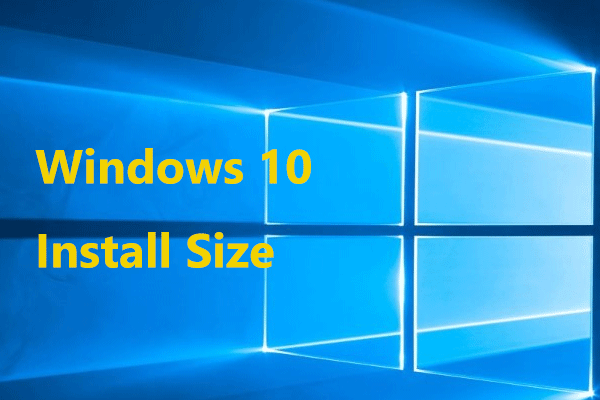

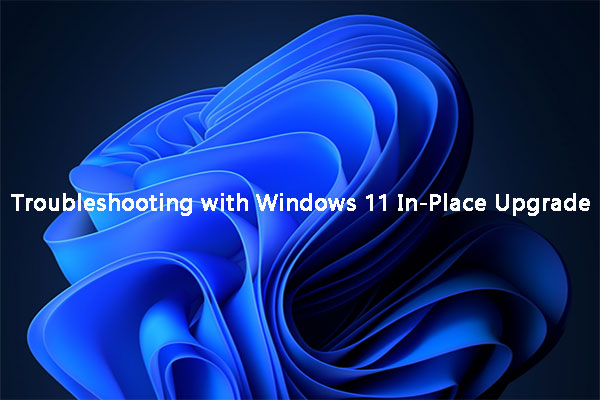
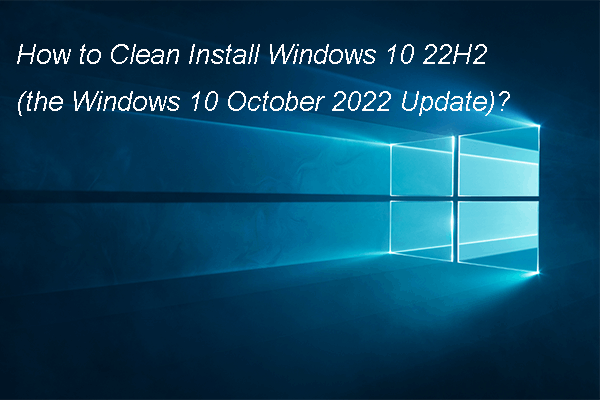
User Comments :